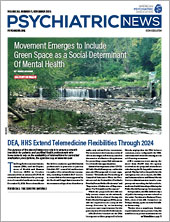Amid the ever-changing landscape of mental health care practice, virtual reality (VR) and augmented reality (AR) have finally made their debut after waiting for many years in the wings. What do experts and critics have to say? At APA’s 2023 Mental Health Innovation Zone (MHIZ), the applications, challenges, concerns, and future prospects of using VR/AR in psychiatry were discussed by key players in the field including Kim Bullock, M.D., a practicing neuropsychiatrist at Stanford and the founder of its Neurobehavioral Clinic and Virtual Reality & Immersive Technologies laboratory; Omer Liran, M.D., a psychiatrist at Cedars-Sinai Medical Center and co-director of its virtual medicine program; and Mark Zang, D.O., a palliative care physician and the associate chief medical information officer for digital innovation at Brigham and Women’s Hospital.
The applications for VR in psychiatry are broad. Common uses include immersive exposure therapy for posttraumatic stress disorder, social anxiety, and phobias. Patients can be exposed to both visual and auditory environments to feared stimuli, confronting and managing their fears safely. VR can also aid clinicians in interactive diagnostics by simulating scenarios and analyzing patient reactions. These applications are just the tip of the iceberg; other uses include immersive environments for cognitive-behavioral therapy, therapist training, remote care appointments, and even research for new therapy techniques. To start, the panelists recommended using commercially available tools such as a MetaQuest or Google headset. Alternatively, a Google Cardboard device can transform 3D videos into a VR experience for under $10. They also suggested the Amelia Virtual Care app for clinicians as a helpful guidance point in psychotherapy practice.
Nonetheless, this ever-evolving technology comes with challenges, a few of which include the following:
•
Skepticism around use: As Bullock stated, for many prospective users, “getting over that skepticism and giving education about how the reptilian brain [the basal ganglia] works, especially with exposure therapy,” becomes a barrier to potential therapeutic use.
•
Regulatory pathways that lack support to keep up with the rate of changing technology: Liran said that he would like the Food and Drug Administration (FDA) to permit the updating of already approved apps without having to obtain the FDA’s re-approval each time.
•
Heterogeneity of VR technology: Zang emphasized that a lot of this technology has not been built specifically for health care use, and adapting it for such use may be like fitting a square peg into a round hole.
•
The lack of regulatory pathways: This is a major concern within the VR community. Bullock is “quite concerned that the rate of technology innovation is outpacing our regulatory processes and oversight.” There are also concerns about potential ethics issues in the absence of strong regulatory foundations. Fortunately, Vang is collaborating with other leaders in the field to establish the American Medical Extended Reality Association (AMXRA), aiming to work with regulatory bodies like the FDA to address some of these safety concerns and regulation pathways in this new field of medicine.
Liran’s lab is developing VR applications specific to health care. The staff write scripts, create storyboards, and review patient feedback. Feedback is taken to the experts and evaluated for possible implementation. This iterative process informs app development, involving continuous consultation with patients and design changes.
Future prospects of VR development for medical applications are broad. Bullock said she imagines something futuristic like the holograms in “Star Trek” and admits it’s almost impossible to predict what our future holds regarding technology expansion into medicine. Liran sees the future of VR in medicine as “revolutionized telehealth with physiological markers integrated with headset technology,” and Vang emphasized that we are moving toward “a world where digital integrates into our reality and becomes the new normal.”
Whether practitioners engage with this technology or not, its impact on medicine is inevitable. Panel discussions like this one at the annual APA Mental Health Innovation Zone provide the perfect space to learn, question, and discuss the progress of these technologies. ■

